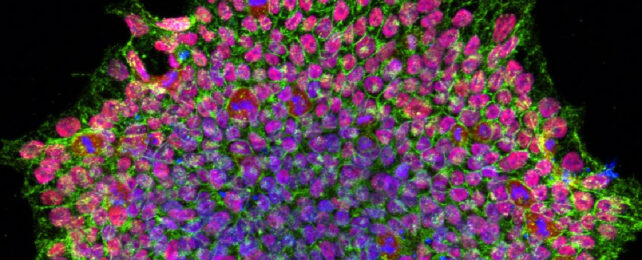Scientists at the University of Sydney have made a groundbreaking discovery by using a quantum computer to slow down and directly observe a key chemical reaction process. This breakthrough allows researchers to unveil details that were previously unseen due to the rapid timescales involved.
The research team, led by joint lead researcher Vanessa Olaya Agudelo and PhD student, utilized a trapped-ion quantum computer in a new and innovative way. By mapping the complex problem onto the quantum device, they were able to slow down the chemical dynamics by a factor of 100 billion.
The team observed the interference pattern of a single atom caused by a common geometric structure in chemistry known as a “conical intersection.” These intersections play a crucial role in rapid photochemical processes such as light harvesting in human vision or photosynthesis.
Directly observing these geometric processes in chemical dynamics has been a challenge for chemists since the 1950s due to the extremely rapid timescales involved. However, by using the quantum computer, the researchers were able to slow down the process and make meaningful observations and measurements.
The findings of this research have been published in the journal Nature Chemistry. The study provides new insights into ultrafast dynamics and how molecules change at the fastest timescales. It also opens up possibilities for advancements in materials science, drug design, solar energy harvesting, and other fields.
The experiment was conducted in the Quantum Control Laboratory of Professor Michael Biercuk, the founder of quantum startup Q-CTRL. The collaborative effort between chemistry theorists and experimental quantum physicists highlights the potential of using quantum technologies to tackle long-standing problems in chemistry.
This groundbreaking research was supported by grants from various organizations, including the US Office of Naval Research, the US Army Research Office Laboratory for Physical Sciences, the US Intelligence Advanced Research Projects Activity, Lockheed Martin, and the Australian Defence Science and Technology Group, among others.
The ability to directly observe and understand these basic processes inside and between molecules opens up a new world of possibilities for scientific advancements. It has the potential to revolutionize fields such as materials science, drug design, and solar energy harvesting, and could also contribute to improving processes related to light-molecule interactions, such as smog formation and ozone layer damage.

What are the potential applications and implications of being able to directly observe and comprehend fundamental chemical processes using quantum technology
Scientists at the University of Sydney have achieved a groundbreaking breakthrough by utilizing a quantum computer to slow down and observe a key chemical reaction process. This discovery allows researchers to reveal previously unseen details that were hindered by the rapid timescales involved.
Led by joint lead researcher Vanessa Olaya Agudelo and a PhD student, the research team employed a trapped-ion quantum computer in a novel way. By mapping the complex problem onto the quantum device, they were able to decelerate the chemical dynamics by a factor of 100 billion.
The team successfully observed the interference pattern of a single atom caused by a common geometric structure in chemistry called a “conical intersection.” These intersections play a critical role in rapid photochemical processes such as human vision and photosynthesis.
Chemists have faced challenges in directly observing these geometric processes in chemical dynamics since the 1950s due to the extremely rapid timescales involved. However, with the use of the quantum computer, the researchers managed to slow down the process and make significant observations and measurements.
The findings of this research have been documented in the journal Nature Chemistry. The study provides fresh insights into ultrafast dynamics and the molecular changes at the fastest timescales. It also paves the way for advancements in materials science, drug design, solar energy harvesting, and other related fields.
The experiment took place in the Quantum Control Laboratory of Professor Michael Biercuk, the founder of quantum startup Q-CTRL. This collaborative effort between chemistry theorists and experimental quantum physicists highlights the potential of utilizing quantum technologies to address longstanding problems in chemistry.
The research received support from various organizations including the US Office of Naval Research, the US Army Research Office Laboratory for Physical Sciences, the US Intelligence Advanced Research Projects Activity, Lockheed Martin, and the Australian Defence Science and Technology Group, among others.
The capability to directly observe and comprehend these fundamental processes within and between molecules presents a myriad of possibilities for scientific advancements. It has the potential to revolutionize fields such as materials science, drug design, and solar energy harvesting. Additionally, it could contribute to improving processes related to light-molecule interactions, such as smog formation and ozone layer damage.


Wow, this groundbreaking discovery will revolutionize the field of materials science and drug design!
Incredible! The potential for quantum computers to unlock new insights in complex chemical reactions is truly awe-inspiring.